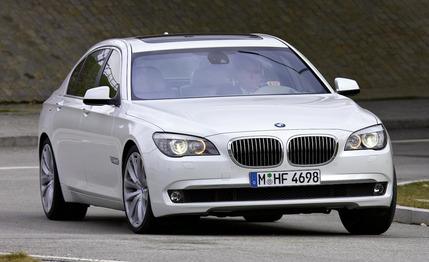 First Drive Review
First Drive Review
Despite rising fuel prices and environmental consciousness, the power race in the luxury segment goes on. Although Europeans prefer their luxury cars with diesel power, the V-12 gasoline engine continues to see strong support in the U.S. and China—and Russia seems to have the fever, too. BMW feels that maintaining a presence in the segment is important for its brand image.
Indeed, BMW is the company that jump-started the V-12 wars in 1987 with the E32 750i/iL, which produced 296 hp from 5.0 liters. It was a huge success, selling 48,600 total units and sending shockwaves through the Mercedes-Benz headquarters in Stuttgart. But it all went downhill from there. Of the last-generation 7-series V-12, the E65/E66 "Bangle butt" car, BMW sold 910 in 2007 and a mere 466 in 2008. Compare that with the more than 14,000 V-12–powered 7-series models built in 1988 alone, and the extent of the decline becomes even more stark. Now BMW hopes to reverse the slide with the all-new 2010 760i and long-wheelbase 760Li (U.S. customers will only get the 760Li).
Force-Fed Progress
To get things right, BMW knew it was going to have to give its V-12 engine a major overhaul. A big reason: The 750i/Li, powered by a twin-turbocharged 4.4-liter V-8, is a pretty good match for the previous 760i/Li in terms of performance. Moreover, the old car's naturally aspirated 438-hp, 6.0-liter mill has been hopelessly left in the dust by Mercedes' twin-turbocharged V-12, which is found under the hood of the S600 and, in AMG tune, the S65.
To wit, there was no serious discussion about pursuing anything other than turbocharging once the decision was made to keep a V-12 at the top of the lineup. "Without turbocharging, we probably would have needed 8.0 liters of displacement," says Wolfgang Nehse, who is responsible for engine testing and integration. He also says this engine is 98 percent new. Although we have little reason to doubt this claim, we note that the new engine’s displacement remains at 6.0 liters, so it seems BMW did not need to start with a blank sheet of paper.
Two Honeywell Garrett turbochargers feed one cylinder bank each, boosting power to 535 hp from the previous engine’s 438. Maximum boost pressure is 13 psi, and the turbochargers are relatively small for quick throttle response and minimal lag. Says Nehse, "We didn't go to the limit."
Not that you’ll really want for more power in this new 760. The sprint to 60 mph should take just over four seconds, with the charge to 100 mph executed in less than 10. Top speed is an electronically governed 155 mph (150 mph for U.S. cars), an offspring of a gentlemen's agreement among German carmakers that BMW initiated with the E32 in 1987. Since 1987, the agreement prevented a competition for ever-higher top speeds, and we suspect it has helped keep Germany's autobahn free of a speed limit thus far. So we are all for the politically correct governor, but we do feel bad for the 760 being kept on such a tight leash. Our educated guess is that the massive sedan could top out near 190 mph.
Maximum torque is 550 lb-ft, available between 1500 and 5000 rpm. That's a slightly lower figure than that of the less powerful 510-hp Mercedes S600, which reaches 612 lb-ft between 1800 and 3500 rpm. Both cars show only the slightest hint of turbo lag.
Six (or Seven) Gears Are for Suckers
The 760i/Li is the first Bimmer to be equipped with a new ZF eight-speed automatic, a gearbox that will work its way into most other BMWs in the near future. Next will be the 5-series GT and then the lesser 7-series models. We hear that all future 5-series models—four-bangers, too—will be equipped with the eight-speed box. Curiously, the transmission will be supplied by ZF to Audi, where its first application will be in the next-generation A8 launching this fall. BMW is quick to point out that it carried out the bulk of the engineering work together with ZF. We are looking forward to hearing Audi's side of the story.